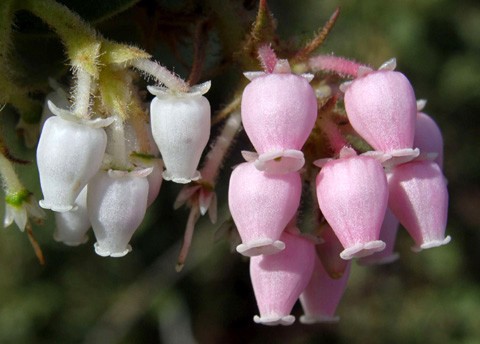Common manzanita
(Arctostaphylos manzanita)

Description
One of many species of manzanita, Arctostaphylos manzanita has the common names common manzanita and whiteleaf manzanita. Arctostaphylos manzanita is endemic to California, where it can be found in the Coast Ranges and Sierra Nevada foothills. It is common on chaparral slopes and low-elevation coniferous forest ecosystems. The Arctostaphylos manzanita leaves are bright shiny green, wedge-shaped and pointed. The small white flowers, only a quarter inch long, are cup-shaped and hang upside down. The fruits are berries which are white when new and turn red-brown as the summer wears on. The bark on the long, crooked branches is reddish, making the shrub easily identifiable as a manzanita. It grows into a twisted tree about 15 feet tall. Like other manzanitas, this species has a hard, attractive wood that has proved useful for making tools and as firewood. The fruit is edible and has a pleasant tartness, but the seeds cause gastrointestinal upset if eaten in large quantities. It has historically been brewed into a cider, including by Native Americans. They are also consumed by bears and chipmunks. Arctostaphylos is a genus of plants comprising the manzanitas and bearberries. They are shrubs or small trees. There are about 60 species, of Arctostaphylos, ranging from ground-hugging arctic, coastal, and mountain species to small trees up to 6 m tall. Most are evergreen (one species deciduous), with small oval leaves 1–7 cm long, arranged spirally on the stems. The flowers are bell-shaped, white or pale pink, and borne in small clusters of 2–20 together; flowering is in the spring. The fruit are small berries, ripening in the summer or autumn. The berries of some species are edible. Arctostaphylos species are used as food plants by the larvae of some Lepidoptera species including Coleophora arctostaphyli (which feeds exclusively on A. uva-ursi) and Coleophora glaucella. Manzanitas, the bulk of Arctostaphylos species, are present in the chaparral biome of western North America, where they occur from southern British Columbia in Canada, Washington to California and New Mexico in the United States, and throughout much of northern and central Mexico. Three species, the bearberries, A. alpina (alpine bearberry), A. rubra (red bearberry) and A. uva-ursi (common bearberry), have adapted to arctic and subarctic climates, and have a circumpolar distribution in northern North America, Asia and Europe.
Taxonomic tree:







